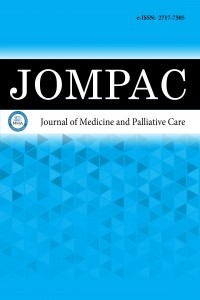
Journal of Medicine and Palliative Care
Yazarlar: ["Abdullah KAHRAMAN", "Güler ERASLAN DOĞANAY"]
Konular:-
Anahtar Kelimeler:Covid-19,Femoral Vein,SARS-COV-2,Thrombosis,Intensive Care,COVID -19,Femoral vein,Intensive care,SARS-COV-2,Thrombosis
Özet: Aim: SARS-CoV-2 can cause an increase in both arterial and venous thrombotic events. It is thought that thrombotic events increase in patients due to deep hypoxia, which is the most serious symptom of patients, and the associated immobility. Material and Method: 233 patients who were followed up in the 3rd Level COVID Intensive Care Unit of the hospital between 2021-2022 were retrospectively analyzed. It was determined that central venous catheter was applied to 110 patients. The age, gender, BMI, co-morbidities of the patients, and which central venous route is preferred for the catheter will be determined. In addition, the number of punctures, thrombocyte count as well as the use of anticoagulants and acetylsalicylic acid, whether or not he/she received total parenteral nutrition (TPN), and how many days the catheter was left will be recorded and thrombotic events will be determined. Results: COVID-19 causes vascular pathologies as well as respiratory symptoms. Central venous catheter application is frequent in intensive care due to both treatment and nutritional support, and venous path preference affects the risk of thrombosis. Performing more than one catheter application from the same area, catheter duration and position of the end part of the catheter are important factors for the development of thrombosis. It has been found that thrombotic events related to femoral catheter have increased in SARS-CoV-2 patients hospitalized in intensive care. In our study, although the duration of femoral catheter use was low, the thrombosis rate was found to be high, which supports the literature. This situation has led us to reduce femoral catheter applications in intensive care SARS-CoV-2 patients hospitalized in our clinic and to prefer other catheterization methods. Conclusion: In this study, the incidence of thrombosis was found to be higher in patients treated in the intensive care unit due to SARS-CoV-2 infection and who underwent femoral central catheterization compared to the literature.